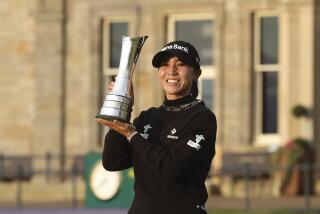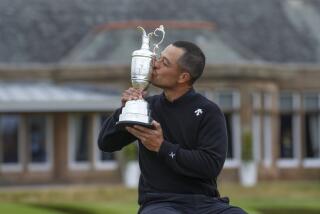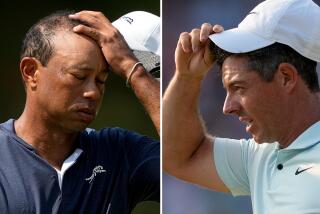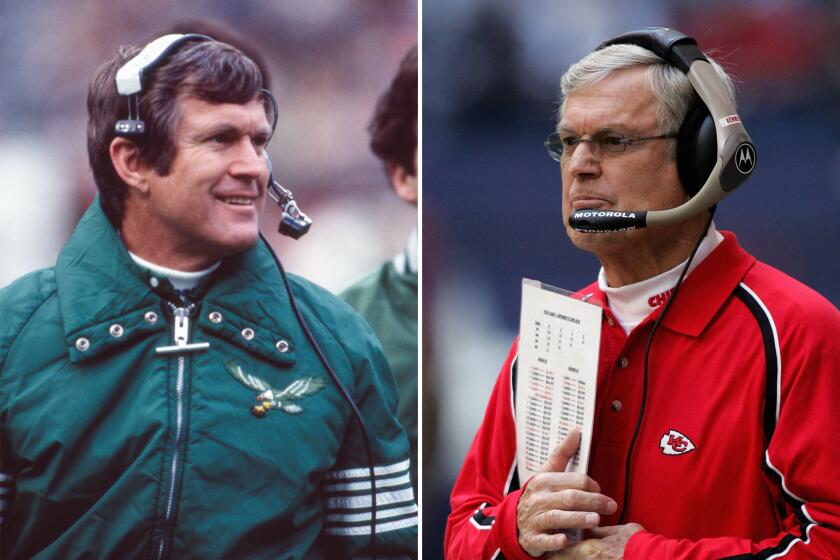The facts
- Share via
* What: 134th British Open golf championship.
* When: Thursday-Sunday (TV coverage: Thursday-Friday, 4 a.m. to 4 p.m., TNT. Saturday, 4 a.m. to 6 a.m., TNT; 6 a.m. to 11:30 a.m., Channel 7. Sunday, 3 a.m. to 5 a.m., TNT; 5 a.m. to 10:30 a.m., Channel 7).
* Where: The Old Course at St. Andrews (7,279 yards, Par 72).
* Format: 72 holes, stroke play.
* Purse: $7.3 million (winner’s share: $1.3 million).
* Defending champion: Todd Hamilton.
* Last year: Hamilton went toe-to-toe with Ernie Els over the final 40 holes at Royal Troon, the last four in a playoff when the well-traveled American made all pars to win by one shot. The final par was the toughest. Hamilton was 40 yards short of the green and used a utility club to chip to two feet. Els missed a 12-foot birdie putt on the 18th for the outright victory, and a 15-foot birdie putt on the 18th that would have extended the playoff. Hamilton closed with a two-under 69 to finish at 274. Phil Mickelson had the lead on the back nine, but finished one shot out of the playoff.
* Last time at St. Andrews: Tiger Woods played 72 holes without hitting into a bunker, overwhelming the Old Course and the field for an eight-shot victory. At age 24, he became the youngest player to win the career Grand Slam. His score of 19-under 269 was the lowest in relation to par at a major.
* Former champions in the field: Hamilton, Els, Woods, John Daly, Nick Faldo, Jack Nicklaus, Ben Curtis, David Duval, Paul Lawrie, Mark O’Meara, Justin Leonard, Tom Lehman, Nick Price, Greg Norman, Mark Calcavecchia, Sandy Lyle, Tom Watson, Tony Jacklin.
* Farewell: Nicklaus will be playing the British Open for the 38th and final time.
* Noteworthy: Americans have won eight of the last 10 British Opens.
* Quoteworthy: “I’ve played there a dozen times and I still feel like I have no idea how to play it.” -- Jim Furyk on St. Andrews.
--
Hole by hole
A look at each hole at the Old Course at St. Andrews:
No. 1 -- 376 yards, par 4
* A short opening hole with no bunkers in the generous fairway, the only issue being the Swilcan Burn that is only a few paces in front of the green. As with everything at St. Andrews, the wind dictates the ease of this hole. It can be a long iron off the tee and a lob wedge, or a driver and mid-iron.
No. 2 -- 453 yards, par 4
* This plays 40 yards longer than in 2000, and hidden bunkers on both sides of the fairway threaten the driving area. The ideal tee shot is between Cheape’s Bunker and the edge of the rough on the right, which has thick gorse. A steep ridge runs through the center of the green.
No. 3 -- 397 yards, par 4
* Another good birdie opportunity in favorable conditions. The drive should be to the right side of the fairway for the best angle to avoid Cartgate Bunker, which is shaped like a crescent and cuts deeply into the left side of the green. A small, subtle ridge in front of the green can produce strange kicks.
No. 4 -- 480 yards, par 4
* Playing 16 yards longer than in 2000, bunkers down the right side could come into play in firm conditions. The fairway tightens slightly at about 350 yards, and the green is protected by a mound in front and a deep bunker to the left.
No. 5 -- 568 yards, par 5
* One of only two par fives on the Old Course, but easily reachable in two unless the wind is into the players’ faces. Seven bunkers threaten the right side of the fairway. If there is a need to lay up, the shot should be placed between two spectacle bunkers. The green is shared with the 13th and is nearly 100 yards wide.
No. 6 -- 412 yards, par 4
* The tee shot is completely blind, over a mass of gorse and heather. A hidden dip runs across the front of the green, making the approach shot deceptive. Still, it should be nothing more than a wedge to a relatively flat putting surface.
No. 7 -- 390 yards, par 4
* This starts the famous St. Andrews loop, a six-hole stretch of short par fours and two par threes. The only true dogleg on the Old Course, so the drive should be down the middle to the side of a large hummock. The green is guarded by Shell Bunker and slopes from left to right.
No. 8 -- 175 yards, par 3
* The only par three on the outward nine, with the skyline of St. Andrews and its prominent towers and steeples on the horizon. A large green is partly obscured by a ridge and a lone bunker.
No. 9 -- 352 yards, par 4
* Might play as a long par three for some big hitters because the green is relatively flat with no trouble in front of it. Two small, but visible, bunkers are the only threat on a hole that should be played aggressively.
No. 10 -- 380 yards, par 4
* In calm conditions, another par four that can be reached off the tee. The landing area is tighter, with rough to the left and on the right that is positioned about 290 yards away. The green slopes much more than the ninth hole.
No. 11 -- 174 yards, par 3
* The final par three, and far more intimidating than the other. It could require a long iron if the wind is up, and the green is guarded by bunkers so severe that Bobby Jones once tore up his card after three swings in one of them. A ball in Strath Bunker in front of the green could require players to go backward. The green slopes severely to the front.
No. 12 -- 348 yards, par 4
* The tee has been pushed back 34 yards, although the green still could be reached in favorable conditions. Craig Wood first drove the green in the 1933 Open, and Sam Snead did it in 1946. There are four hidden bunkers in the fairway, and the hole location dictates the line of the tee shot. A steep slope guards the front of a narrow green that is hard to hold.
No. 13 -- 465 yards, par 4
* A killer stretch of holes begins with a shot that must avoid a line of the Coffin bunkers down the left side. The tee has been moved back 35 yards. The approach could require a long iron, which must carry the entire way to a green that is slightly elevated, and should stay left of the flag.
No. 14 -- 618 yards, par 5
* Despite an additional 37 yards off the tee, massive Hell Bunker should not pose a threat on the second shot unless the wind is strong into the players. There is out-of-bounds to the right and a group of bunkers called “The Beardies” to the left that require a 250-yard carry. Into the wind, the second shot should be played toward the fifth fairway to avoid Hell Bunker. The approach is to a plateau green that is hard to hold.
No. 15 -- 456 yards, par 4
* The fairway tightens at about 300 yards, and the drive should be aimed at the church steeple between two hillocks. The approach is open to a sloping green, but it should be a high shot to avoid the humps and bumps in front of the green.
No. 16 -- 423 yards, par 4
* There is out-of-bounds to the right and Principal’s Nose bunkers in the middle of the fairway about 270 yards off the tee. The drive should be left of those three bunkers to set up an open shot to a green that rises sharply at the front.
No. 17 -- 455 yards, par 4
* The Road Hole is the most famous in the Open rotation. Tee should be aimed at the “o” in “Course” on the “Old Course Hotel” sign, over the edge of the out-of-bounds wall to a narrow fairway. Approach should be to the right half of the green to avoid the Road Hole Bunker. Anything long will result in a shot from the road behind the green.
No. 18 -- 357 yards, par 4
* The closing hole is short, simple and dramatic. It can be reached from the tee, but a road runs along the right side, and shots toward the green -- the first or the second -- must carry a swale known as the “Valley of Sin.” Most famous part of the hole is the Swilcan Bridge, which Jack Nicklaus will cross for the last time in competition -- on either Friday or Sunday.
Source: Associated Press
--
Now you know
Past champions of the British Open at St. Andrews:
Tom Kidd 1873
Bob Martin 1876, 1885
Jamie Anderson 1879
Robert Ferguson 1882
Jack Burns 1888
Hugh Kirkaldy 1891
J.H. Taylor 1895, 1900
James Braid 1905, 1910
Jock Hutchison 1921
Bobby Jones 1927
Denny Shute 1933
Richard Burton 1939
Sam Snead 1946
Peter Thomson 1955
Bobby Locke 1957
Kel Nagle 1960
Tony Lema 1964
Jack Nicklaus 1970, 1978
Seve Ballesteros 1984
Nick Faldo 1990
John Daly 1995
Tiger Woods 2000
More to Read
Go beyond the scoreboard
Get the latest on L.A.'s teams in the daily Sports Report newsletter.
You may occasionally receive promotional content from the Los Angeles Times.










